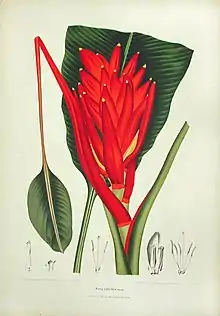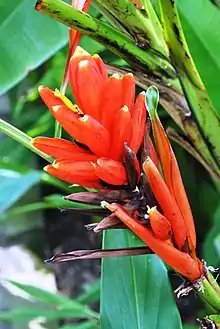| Scarlet banana | |
|---|---|
 | |
| Illustration of inflorescence | |
| Scientific classification | |
| Kingdom: | Plantae |
| Clade: | Tracheophytes |
| Clade: | Angiosperms |
| Clade: | Monocots |
| Clade: | Commelinids |
| Order: | Zingiberales |
| Family: | Musaceae |
| Genus: | Musa |
| Section: | Musa sect. Callimusa |
| Species: | M. coccinea |
| Binomial name | |
| Musa coccinea | |
| Synonyms[3] | |
|
Quesnelia lamarckii Baker | |
Musa coccinea, commonly known as scarlet banana[4] or red-flowering banana,[5] is a species of flowering plant in the banana and plantain family Musaceae, native to tropical China (in Guangdong, Guangxi, and southeastern Yunnan) and Vietnam.[4] It is a bat-pollinated[6] evergreen perennial, placed in section Callimusa (now including the former section Australimusa), having a diploid chromosome number of 2n = 20.[7]
The flower cluster is more rounded than in the related species M. beccarii. It is made up of erect spirals of red bracts which enclose tubular yellow flowers. The inedible fruits are orange, only about 2 cm (0.8 in) long, and contain seeds.[8] The species is cultivated for its ornamental value,[4] being grown, for example, along with heliconias in commercial farms in Hawaii.[8] It does not tolerate temperatures below 10 °C (50 °F), so in temperate zones requires protection during the winter months. In the UK it has gained the Royal Horticultural Society’s Award of Garden Merit.[9][10]
M. coccinea is a known host in the New World of the red palm mite (Raoiella indica).[5]
Taxonomy

Musa coccinea was described by Andrews in 1799. M. uranoscopos Lour. (an illegitimate name) is often incorrectly given as a synonym. Loureiro's 1790 account is confused. He refers to an illustration in Rumphius' 1747 Herbarium Amboinense, hence this is the type of his name. However, this illustration had previously been used in Linnaeus' description of M. troglodytarum, so M. uranoscopos Lour. is a superfluous name for M. troglodytarum. Loureiro's description is of M. coccinea; however the type rather than the description determines the synonymity, so M. uranoscopos Lour. is not a synonym of M. coccinea.[11]
References
- ↑ Allen, R. & Plummer, J. (2020). "Musa coccinea". IUCN Red List of Threatened Species. 2020: e.T111907070A111907072. Retrieved 25 February 2022.
- ↑ Musa coccinea was originally described and published in Botanist's Repository, for new, and rare plants. 1: , pl. 47. 1799. "Name - !Musa coccinea Andrews". Tropicos. Saint Louis, Missouri: Missouri Botanical Garden. Retrieved June 4, 2011.
Type-Protologue: Locality: Thomas Evans received it about the year 1792, from China. Our figure was taken, in part, from a plant which flowered at James Vere's, last December, and partly from one in blossom about the same time, at the Hon. Lady Archer's
- ↑ "Musa coccinea", World Checklist of Selected Plant Families, Royal Botanic Gardens, Kew, retrieved 2013-01-24
- 1 2 3 "Musa coccinea". Germplasm Resources Information Network. Agricultural Research Service, United States Department of Agriculture. Retrieved June 4, 2011.
- 1 2 Cal Welbourn (May 1, 2009). "Pest Alert for Red palm mite Raoiella indica Hirst (Acari: Tenuipalpidae)". Florida Department of Agriculture & Consumer Services, Division of Plant Industry. Archived from the original on December 2, 2010. Retrieved June 4, 2011.
- ↑ Theodore H. Fleming; Cullen Geiselman & W. John Kress (November 2009). "The evolution of bat pollination: a phylogenetic perspective". Annals of Botany. Oxford University Press. 104 (6): 1017–1043. doi:10.1093/aob/mcp197. PMC 2766192. PMID 19789175.
- ↑ Wong, C.; Kiew, R.; Argent, G.; Set, O.; Lee, S.K. & Gan, Y.Y. (2002). "Assessment of the Validity of the Sections in Musa (Musaceae) using ALFP". Annals of Botany. 90 (2): 231–238. doi:10.1093/aob/mcf170. PMC 4240415. PMID 12197520.
- 1 2 Ploetz, R.C.; Kepler, A.K.; Daniells, J. & Nelson, S.C. (2007). "Banana and Plantain: An Overview with Emphasis on Pacific Island Cultivars". In Elevitch, C.R (ed.). Species Profiles for Pacific Island Agroforestry (PDF). Hōlualoa, Hawaii: Permanent Agriculture Resources (PAR). Retrieved January 10, 2013.
- ↑ "RHS Plantfinder - Musa coccinea". Retrieved 4 April 2018.
- ↑ "AGM Plants - Ornamental" (PDF). Royal Horticultural Society. July 2017. p. 65. Retrieved 4 April 2018.
- ↑ Häkkinen, M.; Väre, H. & Christenhusz, M.J.M. (2012). "Identity of a Pisang – historical concepts of Musa (Musaceae) and the reinstatement of Musa troglodytarum". Folia Malaysiana. 13 (2): 1–14.
External links
- Pictures from PlantSystematics.Org
